Fortunately, there are ways to enjoy your favorite dishes with healthier substitutions that taste just as great.
Jump to a Healthy Recipe
- Whole Wheat Lavash Veggie Pizza
- Butternut Squash Mac and Cheese
- Turkey Burger Lettuce Wraps
- Pesto Zucchini Noodles
- Greek Yogurt Ranch
- Cauliflower Alfredo Pasta
- Cauliflower Pizza
- Quinoa Stuffed Bell Peppers
- Sweet Potato Black Bean Enchiladas
- Chicken Salad Wraps w/ Greek Yogurt
- Portobello Mushroom Burgers
Healthy Recipes Can Also Satisfy Cravings
Comfort food is comforting because, in part, it both fulfills a craving and creates a sense of nostalgia. By making some healthy substitutions and swapping out processed ingredients for delicious and nutritious alternatives, you can satisfy your cravings, achieve that same nostalgia, and stay healthy while doing it. Whether you’re trying to lose weight or just want to improve your health, here are some healthier alternatives to your favorite comfort foods.
Whole Wheat Lavash Veggie Pizza
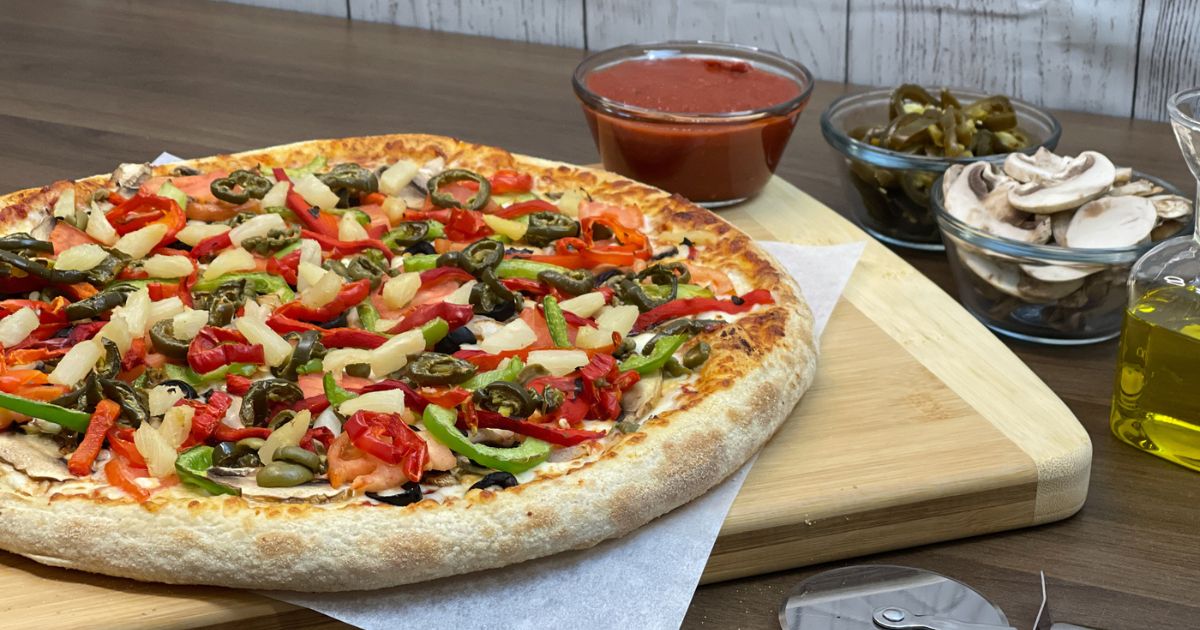
This whole wheat lavash veggie pizza has a thin and crispy crust topped with vibrant veggies and yummy cheese. You’ll eliminate processed white flour and cured meats while adding whole grains and plenty of veggies.
Makes: 2 servings
To make this Whole Wheat Lavash Veggie Pizza, you’ll need:
- 2 whole wheat lavash flatbreads
- 1 c mozzarella cheese, shredded
- 1 c tomato sauce
- 1/2 c sliced bell peppers
- 1/2 c sliced mushrooms
- 1/2 c sliced red onion
- 1/2 c sliced cherry tomatoes
- 1/4 c sliced black olives
- Optional: Fresh basil leaves, torn
- Optional: Crushed red pepper flakes
Directions:
- Preheat the oven to 400°F.
- Place lavash flatbreads on parchment paper-lined baking sheets.
- Spread half of the tomato sauce evenly over each lavash flatbread. Leave a small border for the crust.
- Sprinkle half of the shredded mozzarella cheese over each lavash flatbread.
- Add sliced vegetables on top of the cheese.
- Bake for 8-10 minutes or until bread is crisp and cheese has melted.
- Remove from oven and cool.
- Optional: Garnish with basil and crushed red pepper flakes.
- Serve
Butternut Squash Mac and Cheese
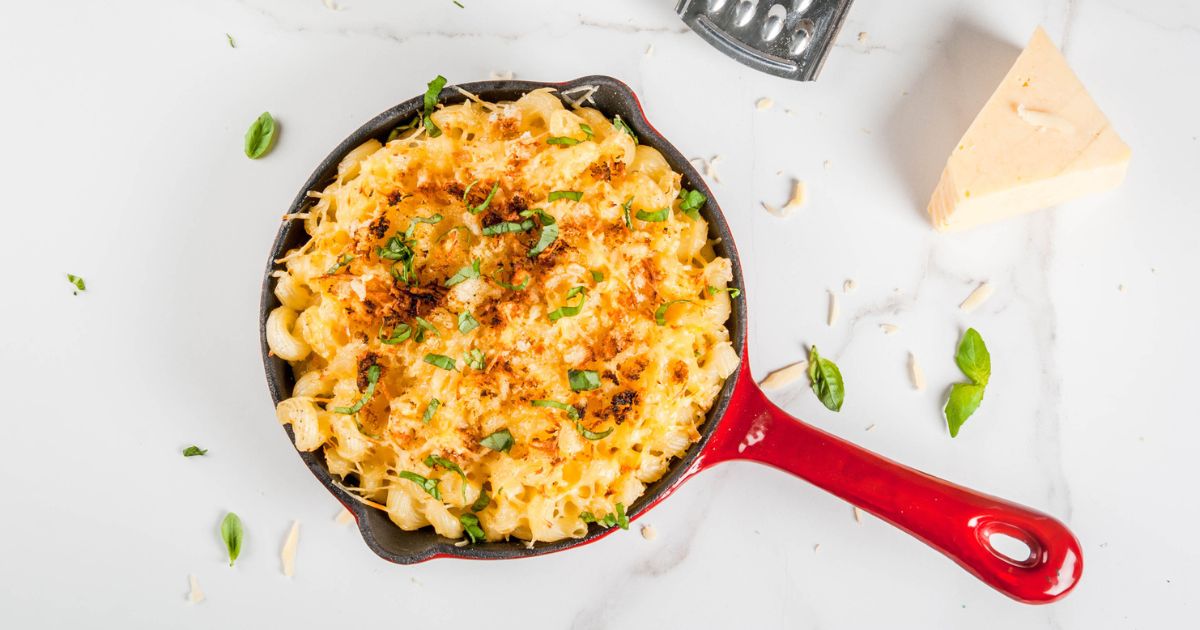
This creamy mac and cheese is made with butternut squash and low-fat or nondairy milk. You can eliminate some unnecessary starch and fat while adding the vitamin A and flavor of butternut squash.
Makes: 4 servings
To make this Butternut Squash Mac and Cheese, you’ll need:
- 2 c butternut squash, diced
- 8 oz. whole wheat or gluten-free pasta
- 1 c milk (low-fat or nut-alternative)
- 1 c sharp cheddar cheese, shredded
- 1 T olive oil
- 1 t garlic powder
- Salt and pepper to taste
- Garlic powder to taste
- Onion powder to taste
- Optional: ¼ c nutritional yeast
Directions:
- Cook the pasta according to the instructions listed on the package.
- Drain pasta and set it aside.
- Cook the diced butternut squash in boiling water for about 10 minutes or until tender.
- Drain squash and place in a blender.
- Add milk, cheddar cheese, nutritional yeast (optional), olive oil, and seasonings to the blender with the cooked butternut squash. Blend until creamy and smooth.
- In a large saucepan, combine the cooked pasta and butternut squash cheese sauce.
- Cook over medium heat, stirring occasionally.
- Enjoy!
Turkey Burger Lettuce Wraps
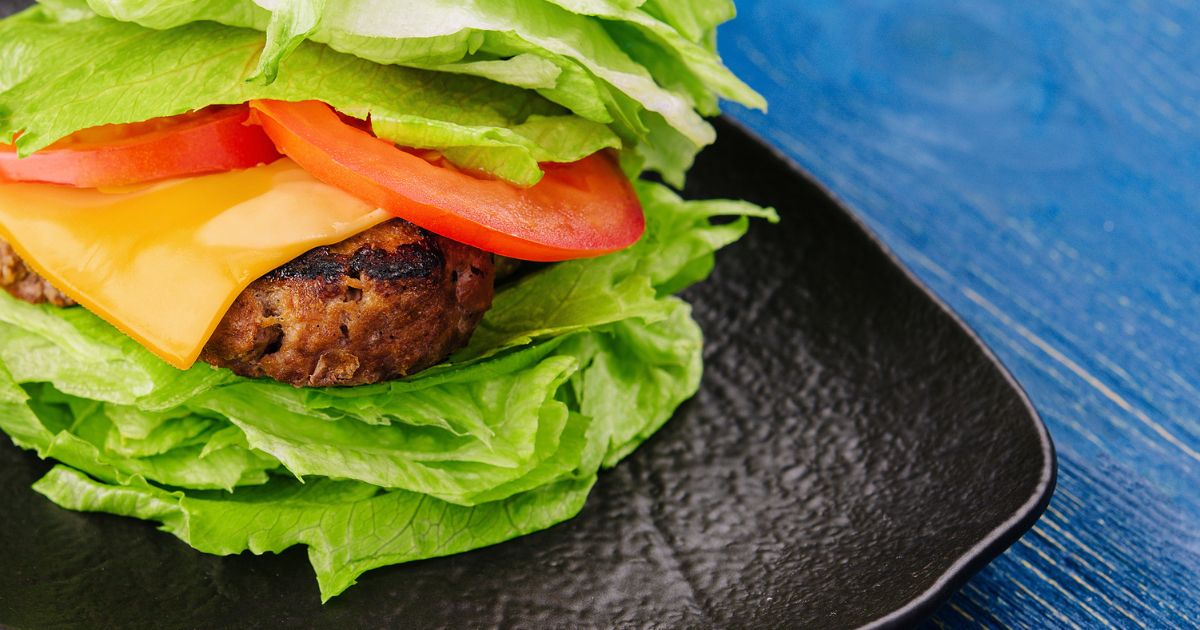
These turkey burger lettuce wraps are a flavorful, lighter alternative to traditional beef burgers. Turkey is a lean, heart-healthy meat that can pack plenty of flavor if seasoned well, while foregoing the traditional bun can eliminate extra calories and starches while adding some delightful crunch.
Makes: 4 servings
To make these Turkey Burger Lettuce Wraps, you’ll need:
- 1 lb lean ground turkey
- 1/4 c chopped onion
- 2 cloves minced garlic
- 1 t Worcestershire sauce
- 1 t smoked paprika
- Salt and pepper
- Lettuce leaves
- Optional: Sliced tomato, avocado, or red onion
Directions:
- In a mixing bowl, combine the ground turkey, chopped onion, minced garlic, Worcestershire sauce, smoked paprika, salt, and pepper. Mix well.
- Divide the mixture into 4 equal portions and shape them into patties.
- Heat a grill or skillet to medium heat. Cook the patties for 4-5 minutes on each side or until 165°F.
- Assemble lettuce wraps – place turkey burger patty on a lettuce leaf and top with sliced tomato, avocado, and red onion if desired.
- Serve.
Pesto Zucchini Noodles

This is a gluten- and processed flour-free alternative to traditional high-carb pasta. Plus, you’ll add vitamin C and B6, as well as minerals like magnesium, calcium, iron, and potassium. If you don’t already have a spiralizer, we highly recommend exploring the potential of spiralized veggies in place of most noodles.
Makes: 2 servings
To make these Pesto Zucchini Noodles, you’ll need:
- 2 medium zucchinis, spiralized
- 1 c fresh basil leaves
- 1/4 c pine nuts or almonds
- 1/4 c Parmesan cheese, grated
- 2 cloves garlic
- 1/4 c extra virgin olive oil
- Salt and pepper
Directions:
- Combine the basil leaves, pine or almond nuts, parmesan cheese, and seasonings in a food processor until finely chopped.
- Gradually drizzle the olive oil into the mixture until the pesto reaches a smooth consistency.
- In a large skillet, heat a tablespoon of olive oil over medium heat. Add the zucchini noodles and sauté for 2-3 minutes until tender.
- Moved cooked zucchini noodles to a serving dish.
- Toss with the homemade pesto.
- Garnish with additional parmesan cheese and fresh basil if needed.
- Enjoy!
Greek Yogurt Ranch

This creamy, tangy, Greek yogurt-based ranch is perfect for dipping chips and veggies. You’ll have all the flavor of ranch – one of America’s signature comfort condiments – without nearly the saturated fat and sodium. Better yet, you’ll get some protein, healthy fats, and fresh herbs (packed with vitamins A, C, and B as well as antioxidants and polyphenols) as an added bonus.
Makes: 1 cup of dip
To make this Greek Yogurt Ranch, you’ll need:
- 1 c plain Greek yogurt
- 1 T fresh chopped parsley
- 2 Tfresh chopped dill
- 1 clove garlic, minced
- 1 T lemon juice
- 1/2 t onion powder
- Salt and pepper to taste
Directions:
- Combine the plain Greek yogurt, chopped fresh dill, chopped fresh parsley, minced garlic, onion powder, lemon juice, salt, and pepper. Stir well.
- Refrigerate for at least 30 minutes and serve chilled.
Notes: For a thinner consistency – ideal if you’d like to drizzle or dunk instead of dip – feel free to add a splash of water or milk.
Cauliflower Alfredo Pasta
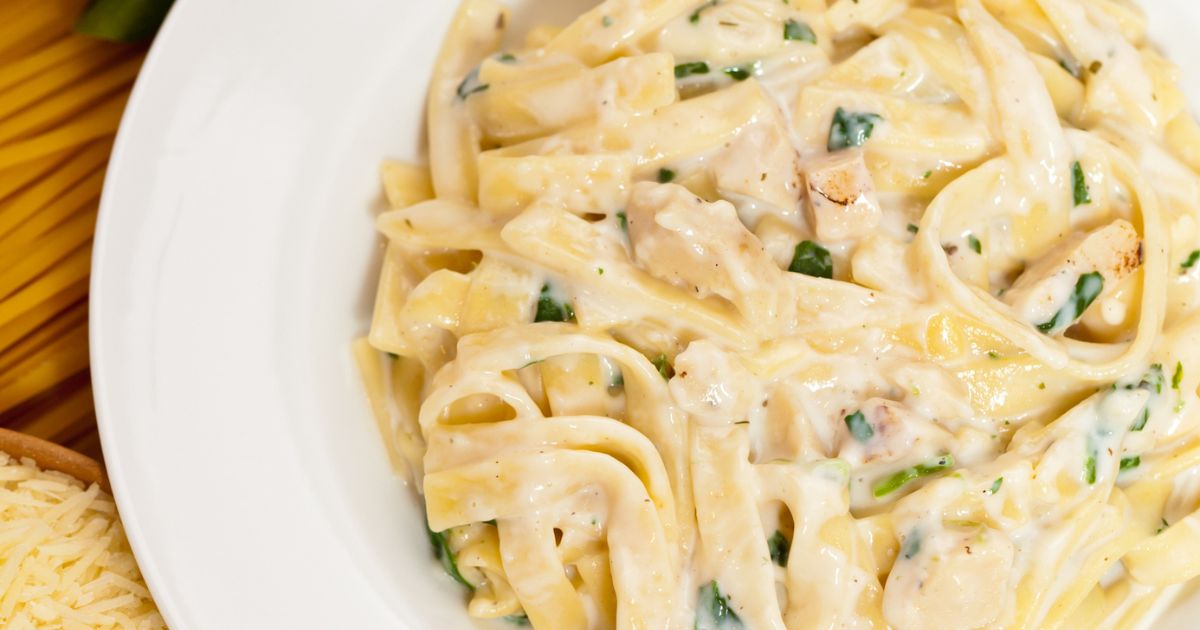
This pasta is a creamy, healthier twist on the classic alfredo pasta. You’ll get the hearty flavor of the pasta beefed up by some veggies that take on the flavor of the sauce – plus some protein, vitamins B and C, iron, magnesium, and calcium.
Makes: 4 Servings
To make this Cauliflower Alfredo Pasta, you’ll need:
- 8 oz whole grain or gluten-free pasta
- 1 head chopped cauliflower florets
- 2 cloves minced garlic
- 1/4 c nutritional yeast
- 1 c low-sodium vegetable broth
- 2 T olive oil
- 1 T lemon juice
- Salt and pepper
- Optional: Fresh chopped parsley
Directions:
- Cook the pasta according to the instructions listed on the package.
- Drain pasta and set it aside.
- Boil cauliflower florets for about 10 minutes or until tender.
- Drain and move to a blender.
- Add minced garlic, vegetable broth, nutritional yeast, lemon juice, olive oil, salt, and pepper to the blender with the cooked cauliflower. Blend until smooth, adding vegetable broth if needed.
- In a large skillet, heat sauce over medium heat
- Add cooked pasta to skillet with sauce and toss until evenly coated.
- Serve and enjoy!
Cauliflower Pizza

This is a low-carb alternative to traditional pizza crust. You’ll add all the vitamins and minerals of cauliflower without the processed white flour.
Makes: 2-3 Servings
To make this Cauliflower Pizza you’ll need:
- 1 head cauliflower, grated
- 1 egg
- 1/2 c mozzarella cheese, shredded
- 1/2 t garlic powder
- 1 t dried oregano
- Salt and pepper
- Pizza toppings of your choice (keep it to veggies, fresh herbs, and lean proteins like chicken and ground turkey)
Directions:
- Preheat oven to 400°F.
- Line a baking sheet with parchment paper.
- In a bowl, combine grated cauliflower, egg, oregano, mozzarella cheese, garlic powder, salt, and pepper. Mix well.
- Put cauliflower mixture on a baking sheet and shape it into a round crust.
- Bake crust for 20-25 minutes or until golden brown.
- Remove the crust from the oven and add toppings.
- Bake for an additional 10-15 minutes or until the cheese is melted.
- Slice and serve.
Quinoa Stuffed Bell Peppers
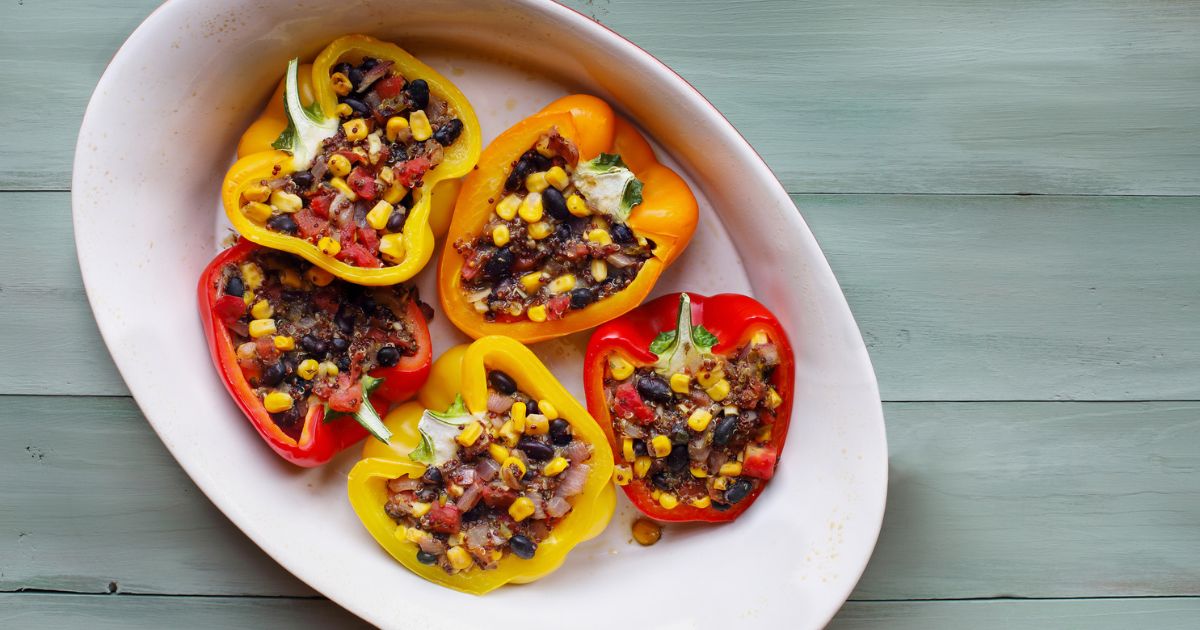
These stuffed bell peppers are bursting with southwest flavor and packed with veggies plus nearly twice the nutritious protein and fiber as the traditional rice-stuffed peppers. In addition, quinoa has a lower glycemic index than rice, which can help you control your blood sugar.
Makes: 4 Servings
To make these quinoa-stuffed bell peppers, you’ll need:
- 4 large bell peppers (cut in half and seeds removed)
- 1 c quinoa
- 1 c diced tomatoes
- 1 c black beans, drained and rinsed
- 1 c corn kernels (fresh or frozen)
- ½ c red onion, diced
- ½ c cheddar cheese, shredded
- ½ teaspoon cumin
- 1 teaspoon chili powder
- Salt and pepper
- Optional: Fresh chopped cilantro
Directions:
- Preheat the oven to 375°F.
- Cook quinoa according to the package.
- Arrange bell pepper halves in a baking dish with the cut side up.
- In a mixing bowl, combine the cooked quinoa, black beans, diced tomatoes, corn kernels, diced red onion, shredded cheddar cheese, and seasonings. Mix well.
- Spoon the quinoa mixture evenly into each bell pepper half.
- Cover the baking dish with foil.
- Bake for 25-30 minutes or until the peppers are tender.
- Uncover and bake for an additional 5 minutes.
- Optional: Garnish with cilantro.
- Enjoy!
Sweet Potato Black Bean Enchiladas
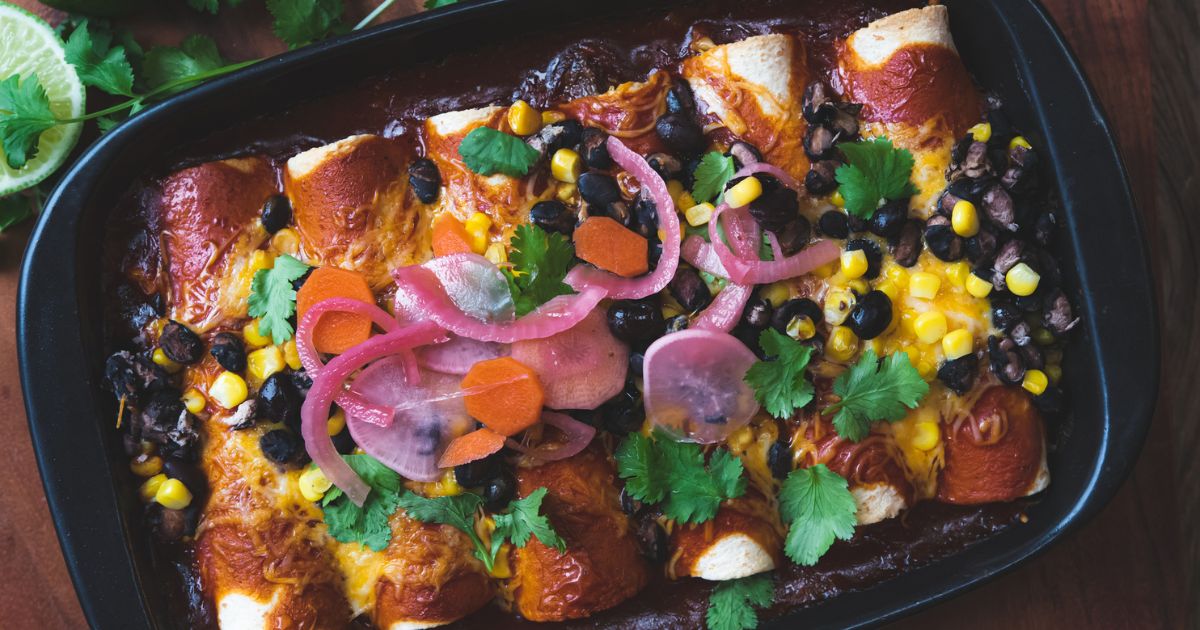
These sweet potato black bean enchiladas are flavorful, rich in protein, fiber, vitamin B and C, and calcium.
Makes: 4 Servings
To make these Sweet Potato Black Bean Enchiladas, you’ll need:
- 8 corn tortillas
- 1 c enchilada sauce
- 2 medium sweet potatoes
- 1 c cooked black beans, drained and rinsed
- 1 clove minced garlic
- ½ c diced red onion
- 1 t ground cumin
- ½ t chili powder
- Salt and pepper
- ½ c shredded Monterey Jack cheese
- Optional: Fresh chopped cilantro
Directions:
- Preheat the oven to 375°F.
- Lightly grease a 9×13-inch baking dish with oil.
- Peel and dice the sweet potatoes.
- Boil sweet potatoes for about 10-15 minutes or until tender.
- Drain and move to a mixing bowl.
- Add beans, diced red onion, minced garlic, ground cumin, and seasonings to the bowl with the sweet potatoes. Mash together.
- Warm tortillas in the microwave or on the stove if desired.
- Spread 2 tablespoons of the enchilada on the bottom of the baking pan.
- Place a spoonful of the sweet potato black bean mixture onto each tortilla.
- Roll tortillas and place fold side down in baking dish.
- Pour the remaining enchilada sauce on the rolled tortillas.
- Sprinkle with shredded cheese.
- Cover the dish with foil and bake for 20-25 minutes.
- Remove foil and bake for an additional 5 minutes or until golden brown.
- Optional: Garnish with cilantro
Chicken Salad Wraps w/ Greek Yogurt

These wraps are a refreshing alternative to a traditional chicken salad. Since they’re made with healthy Greek yogurt instead of mayonnaise, they reduce saturated fat and sodium while adding healthy fats and protein.
Makes: 4 Servings
To make these Chicken Salad Wraps w/ Greek Yogurt, you’ll need:
- 4 whole grain tortillas
- Lettuce leaves
- 2 c cooked shredded chicken breast
- ½ c plain Greek yogurt
- 2 T diced red onion
- ¼ c diced cucumber
- ¼ c diced red bell pepper
- 2 T chopped fresh dill
- 1 T lemon juice
- Salt and pepper
Directions:
- Combine shredded cooked chicken breast, greek yogurt, diced red bell pepper, diced red onion, diced cucumber, chopped fresh dill, lemon juice, salt, and pepper. Mix well.
- Line whole grain tortillas with lettuce leaves.
- Add chicken salad mixture tortillas.
- Roll tightly to form wraps.
- Slice the wraps in half diagonally.
- Serve and enjoy!
Portobello Mushroom Burgers
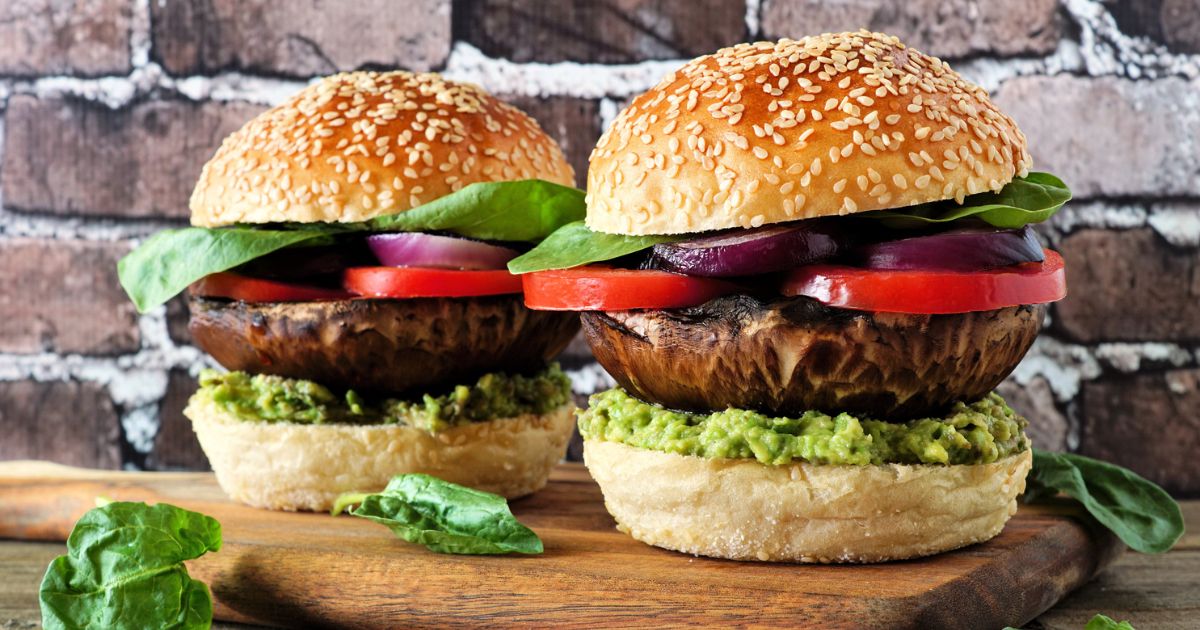
These burgers are a vegetarian-friendly alternative to beef burgers made with tasty portobello mushrooms. By eliminating red meat and swapping in mushrooms, you’ll reduce cholesterol risk while adding flavor, B-group vitamins, selenium, and zinc.
Makes: 4 servings
To make these Portobello Mushroom Burgers, you’ll need:
- 4 whole grain hamburger buns
- 4 large portobello mushroom caps
- ¼ c balsamic vinegar
- 2 T olive oil
- 2 cloves minced garlic
- 1 t dried thyme
- Salt and pepper
- Burger toppings: (e.g., lettuce, tomato slices, red onion slices, avocado slices, mayo, ketchup, mustard)
Directions:
- To make a marinade, whisk balsamic vinegar, olive oil, minced garlic, dried thyme, salt, and pepper in a bowl.
- Marinade the portobello mushroom caps in the mixture for 30 minutes. Flip them after 15 minutes.
- Preheat a grill or skillet over medium heat.
- Remove the portobello mushroom caps from the marinade.
- Shake off any excess marinade.
- Grill for 4-5 minutes on each side
- Place mushrooms on buns and add toppings.
- Serve!
You Can Eat All Your Favorite Comfort Foods While Staying Healthy

Unhealthy fats and processed foods can sometimes contribute to feelings of sluggishness, as well as excess weight, risk of heart disease, diabetes, depression, anxiety, and more. Choosing healthier, nutritious alternatives can help you feel better, both physically and mentally. When you consume nutrient-packed ingredients like veggies, lean proteins, and whole grains, your body gets the fuel it needs to function at peak levels – and you’ll be much happier with how you feel and how you look.
Although traditional comfort food is often high in fats, sugars, and processed ingredients, there are ways to make them healthier so that you can enjoy them guilt-free. Put simply, healthy comfort food is indeed doable. With a little creativity in your cooking methods and your ingredients, you can enjoy the comforting flavors you love while still nourishing your body. Just be sure to focus on portion control when indulging in all of your favorite meals.
For more information about staying healthy, tune in to the Arizona Gynecology Consultants blog. If you’d like more personalized recommendations for improving your health and losing weight, please request a consultation with our team today!

Nurse Practitioner
Ashley is a board certified Nurse Practitioner who is excited to follow her passion back into women’s health. She has five years of experience as a Nurse Practitioner in family medicine, as well as, five years of bedside experience in high risk labor and delivery.
Ashley is a native of Illinois, but moved to Arizona in 2015 to accelerate her nursing career. She achieved her Bachelor’s of Science in Nursing from Clarke University in Dubuque, Iowa where she also played volleyball. While working as a nurse in 2017 at Banner University Medical Center, she completed her Master’s of Science in Nursing at Chamberlain College of Nursing.
















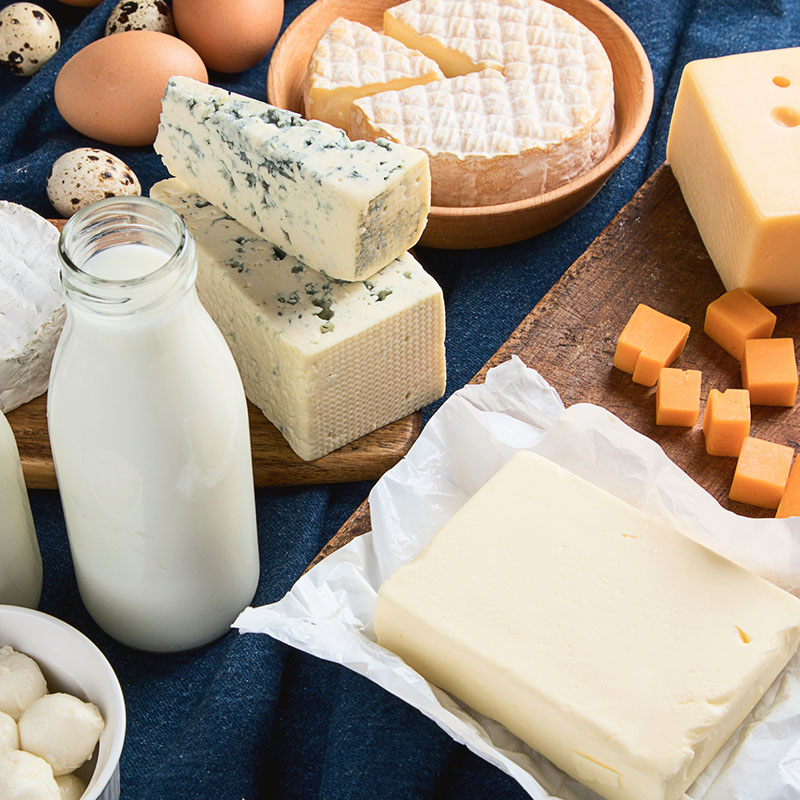
 Another important factor when it comes to your healthy lifestyle is your level of physical activity. You want to find a balance between your level of activity and what you put into your body. Often, people assume if they work out a lot, they can eat whatever they would like. This couldn’t be further from the truth. These two elements go hand in hand more than you’d think. Even if you are unable to do extensive physical exercise, making small changes can make a huge impact. This can include parking further from the entryway to a store, taking the stairs versus an elevator, or doing a round of squats during a commercial break on your favorite tv show. Every little step throughout the day adds up.
Another important factor when it comes to your healthy lifestyle is your level of physical activity. You want to find a balance between your level of activity and what you put into your body. Often, people assume if they work out a lot, they can eat whatever they would like. This couldn’t be further from the truth. These two elements go hand in hand more than you’d think. Even if you are unable to do extensive physical exercise, making small changes can make a huge impact. This can include parking further from the entryway to a store, taking the stairs versus an elevator, or doing a round of squats during a commercial break on your favorite tv show. Every little step throughout the day adds up. For expert women’s health services in Arizona, contact us here at Arizona Gynecology Consultants. We specialize in the unique needs for women’s health and provide expert care. If you need help with weight loss or have another specific need, we are here for you. Our weight loss program is individualized for your needs.
For expert women’s health services in Arizona, contact us here at Arizona Gynecology Consultants. We specialize in the unique needs for women’s health and provide expert care. If you need help with weight loss or have another specific need, we are here for you. Our weight loss program is individualized for your needs.
 There have been countless fad diets to come and go throughout the years. There are also thousands of supplements on the market that proclaim to boost your metabolism and burn fat with minimal effort. Be wary of these fads and gimmicks. While some fast fat-burning methods may offer seemingly good results in a short window of time, these methods are rarely healthy and more often than not cause more problems than they solve.
There have been countless fad diets to come and go throughout the years. There are also thousands of supplements on the market that proclaim to boost your metabolism and burn fat with minimal effort. Be wary of these fads and gimmicks. While some fast fat-burning methods may offer seemingly good results in a short window of time, these methods are rarely healthy and more often than not cause more problems than they solve.
